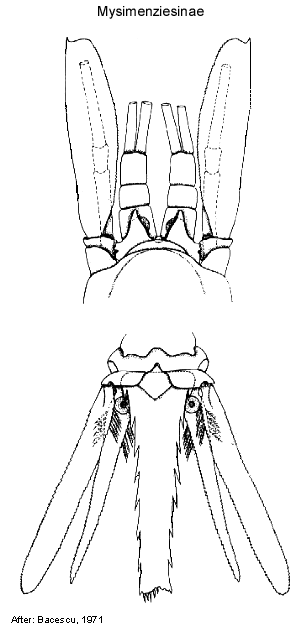 |
||||||
|
|
|
|
|
|
Mysidacea: Families, Subfamilies and TribesKenneth MelandMysimenziesinae Tchindonova, 1981 Diagnostic description. Head. Carapace large, only last thoracic somite uncovered. Rostrum broadly rounded. Eyes reduced (forming two acutely pointed triangular processes, with no visual pigmentation). Antenna (antenna 2) scale without apical suture, outer margin smooth, without setae, with terminal spine. Labrum symmetric. Mandible lacinia mobilis reduced or absent (absent, replaced with a large protuberence covered with serrate setae), spine row absent, molar process well developed. Thorax. 1st maxilliped exopod absent. 2nd thoracopod developed as a maxilliped, exopod well developed. 3rd-8th thoracopods endopod with distinct carpus and propodus, propodus divided into two segments. Branchiae on thoracopods absent. Marsupium composed of three pairs of oostegites. Abdomen 6th & 7th abdominal somites fused. Female pleopods uniramous or greatly reduced. Uropod endopod setose around entire margin, statocyst present; exopod complete, setose around entire margin. Telson apex cleft (and lateral margins serrated with large incisions). Generic composition. Mysimenziesinae 1 genus (1 species): Mysimenzies hadalis Bacescu, 1971. Remarks. Mysimenziesinae is described from a single female specimen from its type locality at 6200m in the Peru Trench. Although a male has not been observed this species is easily recognized by it's large size (50 mm) and serrated telson. Mysimenzies was orginally placed within the tribe Erythropini and later used to establish the monotypic sub-family Mysimenziesinae Tchindonova, 1981. Note that the exact systematic posistion of this genus can not be satisfied until male morphology is known.
Cite this publication as: 'Meland, K. (2002 onwards). Mysidacea: Families, Subfamilies and Tribes. Version 1: 2 October 2002. https://crustacea.net'. |
|
|
|
|
|
|
|
|
|
Copyright © Australian Museum, 2002 - 2003
Australian Museum website
